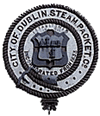 |
 |
 |
||||||
The City of Dublin Steam Packet CompanyCharles Wye Williams was born in Dublin in 1779, the younger son
of Thomas Williams, Secretary of the Bank of Ireland. In 1822 he founded
a shipping company, "Charles Wye Williams and Co." The company
name was later changed to "The City of Dublin Steam Packet Company"
(CDSPCo). From 24 January 1839 the Post Office contracted the CDSPCo to run a night mail service across the Irish Sea.. The Admiralty were contracted to operate a day service. From 1 January 1850 the CDSPCo secured the contract to run both the day and the night mail service. In 1859, to update their fleet, the CDSPCo placed orders for the construction of four paddle steamers. The ships were named after Ireland's provinces Connaught, Leinster, Munster, and Ulster and were often referred to as the Provinces. They used the prefix R.M.S., which stood for Royal Mail Steamer. (Other famous ships to carry the R.M.S. prefix were the Titanic and the Lusitania). The mail was sorted on board ship by staff of the Dublin post office. The ships carried mail across the Irish Sea until near the end of the century. They operated from the Carlisle pier at Kingstown, Co. Dublin, Ireland and the Admiralty pier at Holyhead, Anglesey, Wales. The mail ships carried passengers from the early days. Eventually passenger traffic became the company's main source of revenue. In 1895, with their mail boats needing to be replaced, the CDSPCo placed an order for the construction of four identical twin-screw steamers. Like their predecessors, the ships were named after the four provinces of Ireland. The Ulster was launched on 27 June 1896, the Leinster on 12 September 1896, the Munster on 21 December 1896 and the Connaught on 21 September 1897. On her trial voyage on Saturday 27 February 1897 the Leinster broke by 6 minutes the existing record of 2 hours and 30 minutes for the crossing between Holyhead and Kingstown.
On the afternoon of 8 September 1902 there was a thick fog at the Kish Bank, off the east coast of Ireland. The RMS Leinster had almost completed her journey from Holyhead to Kingstown. In the reduced visibility she rammed and sunk the wooden Kish Bank light ship Albatross. Luckily, there was no loss of life. The crew of the Albatross were taken on board the Leinster. Having suffered no more than a few dents on her plates, the Leinster sailed for Holyhead the following morning. The ships of the CDSPCo had no further major incident until the later part of the First World War. During World War 1 Ireland, as part of what was then the United Kingdom of Great Britain and Ireland, was at war with Germany and her allies. On 3 March 1917 the RMS Connaught, which had been requisitioned for wartime service by the Admiralty, was torpedoed and sunk in the English Channel with the loss of three crewmen. In late 1917 the remaining three Provinces on the Kingstown to Holyhead route began to come under U-boat attack. The frequency of the attacks increased in 1918. But, despite a number of narrow escapes, the ships managed to survive. Then, on 10 October 1918, a few weeks before the end of the war, disaster struck the CDSPCo when the RMS Leinster was sunk with the highest ever loss of life on an Irish owned ship.
Continue reading The Canadian Connection... |
|
|||||

